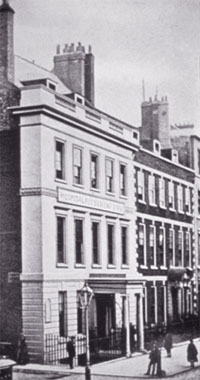BRITAIN’S first in-patient hospital specifically for sick children opened its doors on February 14th, 1852, located in a four-storey 17th century townhouse in the Bloomsbury district of London.
With just 10 beds and two resident physicians, the pioneering hospital was the brainchild of Dr Charles West, who was driven by the shockingly high infant mortality rate in the capital. Originally called the Hospital for Sick Children, it soon became better known by its location, at 49 Great Ormond Street.
 Founded almost a century before the advent of the NHS, it was a ‘voluntary hospital’, relying on charitable donations, fundraising and doctors giving their services for free. However, Dr West, as well as being the driving force behind the hospital and its first physician, was an influential and persuasive man. He managed to secure the patronage of Queen Victoria, knowing it would inspire other wealthy and philanthropic Victorians to follow suit and support the hospital.
Founded almost a century before the advent of the NHS, it was a ‘voluntary hospital’, relying on charitable donations, fundraising and doctors giving their services for free. However, Dr West, as well as being the driving force behind the hospital and its first physician, was an influential and persuasive man. He managed to secure the patronage of Queen Victoria, knowing it would inspire other wealthy and philanthropic Victorians to follow suit and support the hospital.
Another influential supporter and personal friend of Dr West was the writer Charles Dickens, whose novels often touched on the dire poverty, illness and appalling conditions endured by children in London. Although the battle for funds was constant, the hospital’s number of in-patient beds soon tripled to 30, with conditions already becoming overcrowded.
More than 4,250 children were also treated as outpatients in only the hospital’s second year, but even that was a drop in the ocean in a city which saw 21,000 children under 10 die each year. Dr West never missed an opportunity to promote his cause. In 1854, when asked to speak about the hospital’s progress, he also told his audience: “Do not then let this Hospital fail for want of funds.
“Visit it for yourselves: see what its daily working is, read the simple tale of good done which its Reports unfold; and then, if you feel for the poor, if you love little children, if you have children of your own, or have had, and lost them, or have had them given back to you when you feared that they would be taken from you for ever — let every motive which policy can suggest, which philanthropy can furnish, affection enforce, or religion sanctify, induce you to join with the Committee, and give them what best you can contribute, your time, your influence, or your money, to forward them in their work.”
By the time of Dr West’s death in 1898, his hospital was treating tens of thousands of children each year and already recognised as a centre of excellence in several areas of paediatric medicine, with its own school of nursing. Some of the country’s most noted physicians would come from treating wealthy patients in their private Harley Street consulting rooms to spend a few hours treating some of London’s poorest and sickest children for free.
Even after the 1948 foundation of the NHS, fundraising continued. While the NHS meets the day-to-day running costs of the hospital, fundraising for the Great Ormond Street Hospital Children’s Charity enables it to remain at the forefront of child healthcare. Over the years the building has expanded and been redeveloped several times, so that the modern hospital now occupies a whole city block between Great Ormond Street and Guildford Street and has almost 400 in-patient beds.
One of the hospital’s constant sources of extra income is from the copyright to the “Peter Pan” works of author J. M. Barrie, and all other feature films, plays, stories and other media which feature his characters. The copyright was gifted to the hospital in 1929 and has provided a significant income stream for the past 90 years. A statue of Peter Pan now stands in a garden at the hospital.
Just a few of the pioneering medical breakthroughs in the history of Great Ormond Street are:
- appointing the UK’s first consultant paediatric surgeon in 1928
- opening the first heart and lung unit (1947) and first leukaemia research unit (1961)
- pioneering the first heart and lung bypass machine for children in 1962, to help repair heart problems
- performing Britain’s first successful bone marrow transplant in 1979
- undertaking the world’s first stem cell supported tracheal transplant in a child
- becoming Europe’s first children’s hospital to offer a portable haemodialysis service
- opening Europe’s first research centre to tackle birth defects in 2012.
To find out more about Great Ormond Street Hospital, its long history and the vital work it does today, visit its website by clicking here.
